Forty yards away antlers slowly rotated in my direction, the ivory tips glowing above the dark of the buck brush. Forty yards, 120 feet, 1,440 inches, give or take. I froze, diverted my eyes, tried very hard to not be there. A lifetime later the buck turned his head back to continue his gaze up the draw.
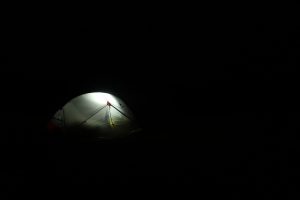
Several days earlier I had again driven the five hours to the badlands in the South of the province, and pitched my tent in the dark. My aging bones welcomed the good mattress and fluffy pillow that come with camping beside the truck.
Before first light the next morning I was sitting above a large coulee, hoping to catch deer move from feeding to bedding. All the prairie roads look the same in the dark, but thanks to iPhone and the right app I found my parking spot without trouble. The traditional in (my) traditional bowhunting stops at using a bow without sights, let-off or other gadgets. The rest is all modern. Still, the challenge is the same as 25 years ago, 100 years ago, two thousand years ago: get within shooting range undetected. Thirty yards or under, for me.
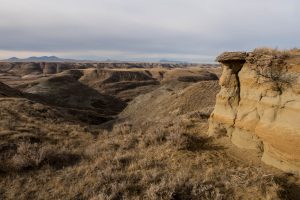 Nothing showed that morning, and I tried another area in the afternoon. Much walking and a lot of glassing revealed nary a deer, until I almost stupidly walked in full view of a bedded buck. Distance and luck kept me from spooking him, and I froze until I was sure that he hadn’t spotted me. Lying right underneath the edge of a shallow draw, with the wind in his back, approaching him would be tricky, but I decided to try just the same.
Nothing showed that morning, and I tried another area in the afternoon. Much walking and a lot of glassing revealed nary a deer, until I almost stupidly walked in full view of a bedded buck. Distance and luck kept me from spooking him, and I froze until I was sure that he hadn’t spotted me. Lying right underneath the edge of a shallow draw, with the wind in his back, approaching him would be tricky, but I decided to try just the same.
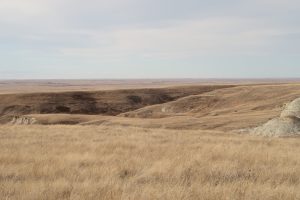 Long story short, I got to within 70-80 yards or so but decided to break off the stalk. I’d either stay out of sight but would have the wind in my back, or I would have to crawl closer through his peripheral vision. Coming back the next day seemed like a better plan.
Long story short, I got to within 70-80 yards or so but decided to break off the stalk. I’d either stay out of sight but would have the wind in my back, or I would have to crawl closer through his peripheral vision. Coming back the next day seemed like a better plan.
Early the next morning I had my binoculars trained on the same area. About an hour after first light four bucks showed up, slowly working their way along the coulee’s edge. Two broke off and bedded low, but two kept getting closer. I decided to try to cut them off, but they were faster. I remember thinking that I was on a fool’s errant, with the bucks having all the advantage, my being on an open slope, and them hidden somewhere around the bend. Two steps later one of the bucks busted me, and the pair departed for healthier surroundings. I really need to start listening to my inner voices better (some of them anyway).
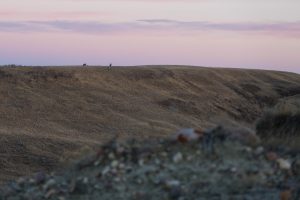
Back at my original look-out I saw a fifth buck approach. A nice 4×4, not too big, but with good mass. He bedded higher up in the draw, in some buck brush. It looked like he was in a position that would offer a stalk. The other bucks were bigger, but opportunity trumps size, so I concentrated on this one. Honestly I would have concentrated on him if he had been a spike. Last day of the season; I really wanted a chance to shoot a buck. Any buck.
All experts (I consider everybody who has shot a mule deer with a bow an expert) seem to suggest that you need to wait, whenever you spot a bedded buck early. He may get up and move, the winds can change, other deer may join him, and if you are off running when this happens, you’ll be in for a surprise during the stalk. I gave him a full hour. He got up once, turned around, and rebedded, now invisible from where I was. My patience spent, I got up and ran.

Half an hour later I was 200 yards from the draw. I set my pack down by a fence post, took off my boots and put on thick socks. I closed the distance as much as I dared, before starting the two-steps-glass routine: take two steps, glass the top of the brush, repeat. If you are lucky, you’ll spot the tips of the bucks antlers before he spots you.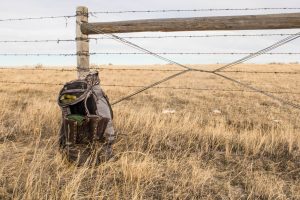
I got lucky! Studying the antlers I figured the buck was facing away, but he was hidden by a lot of brush. I, however, was in short grass and cactus, fully exposed. In retrospect I think my next move was a mistake. Wanting to stay out of sight I decided to sit down, put the bow with an arrow nocked in my lap, and butt crawl closer. I remember noticing that this was louder than walking (see note above of learning to listen to inner voices), but I continued.
When the buck moved his head the first time, I ranged him (in defense, my range finder is fairly old – almost traditional). Forty yards. I got a little closer, and then another little bit. The wind was steady in my face, but it was only a breeze, not enough to block all sound. And then, just like that, the buck rose from his bed, and turned his head towards me. He wasn’t spooked, didn’t appear concerned, but my bow was in my lap and my hands by my side. He peered at me for a minute, or maybe two, and then slowly turned and walked away. It would have been a long shot, probably best not taken at an alert deer. I watched him disappear, and later reappear on the coulee’s edge with his two buddies in tow. Never in a hurry, as if they knew that I couldn’t bridge the gap.
Two hours later I put my bow target at 37 yards, walked back, drew and released. The arrow made a beautiful arc against the blue October sky and landed inside the ten ring.
Next year.
F.